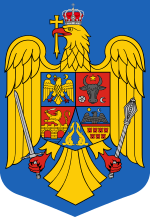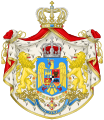Coat of arms of Romania
| Coat of arms of Romania | |
|---|---|

|
|
| Details | |
| Introduced | 2016 |
| Heraldic shield | Eagle |
The current coat of arms of Romania has existed since 2016.
symbolism
The Romanian coat of arms shows a golden eagle as a central element . This eagle also appears on the coats of arms of the Argeş County and the cities of Piteşti and Curtea de Argeş . It symbolizes the Basarab dynasty , which made it possible for the Țara Românească (= "Romanian country") to form. The eagle, symbol of Latin roots and nobility, stands for courage, determination, the striving for something higher, strength and greatness. The azure colored shield symbolizes the sky. The eagle holds the symbols of power in its claws: a mace and a sword . The latter is said to commemorate the Moldovan ruler Ștefan cel Mare (Stefan the Great, 1457–1504), who was also known under the name "The Athlete of Christ". The mace is said to boast Mihai Viteazul (Michael the Brave, 1593–1601), the first to unite the Romanian lands.
On the eagle's chest there is a shield, divided into five fields, with the coats of arms of the historical Romanian provinces: In the first field the golden eagle stands for Țara Românească for (Great) Wallachia , in the second field the head of an aurochs for Moldavia , im the third field combines symbols for the Banat (the bridge) and for the Little Wallachia (the lion), in the fourth field the two dolphins stand for the Dobruja , and the fifth field shows the coat of arms of Transylvania , traditionally the black turul for the Hungarians , The sun and the half moon represent the Szeklers and the seven towers represent the Transylvanian Saxons . In the case of the Walachian eagle, the derivation from the Hungarian turul bird is also discussed. Organizationally , the Romanian principalities emerged from vassal states that were established by King Béla IV (Hungary) to protect the Hungarian eastern border after the Mongol invasion.
history
After the unification of Wallachia and Moldova, the coats of arms of the two principalities were used, but the coat of arms was not used uniformly in the 1860s and varied in the representations. In 1866 the Hohenzoller Carol I became prince and a year later a law was passed describing the appearance of the coat of arms. The two eagles stood for Wallachia and the two aurochs for the Vltava. The small shield with the silver-black colors stood for the Hohenzollern.
In 1872 there was a change in the coat of arms. In the lower half a lion for the little Wallachia and two dolphins for the Dobrudscha are shown.
After the First World War , Romania's territory expanded considerably and the coat of arms was adapted. The second field now symbolized Moldova with Bessarabia and Bukovina , the third field (below) the Banat, the fourth field Transylvania and below in between Dobruja.
Coat of arms of socialist Romania (until 1989)
After the Second World War , Romania came under the influence of the Soviet Union and all coats of arms were banned. In 1948 an emblem based on the Soviet model was chosen, on which a tractor was depicted and which bore the lettering RPR ( Republica Populară Română , German People's Republic of Romania ) and was framed with ears of wheat.
However, it was changed that same year. Now a landscape with a green field, fir forest, mountain range and derrick was depicted on it. In 1952 the typical Soviet red star was added and after the Socialist Republic of Romania was proclaimed in 1965 , the RPR logo was replaced by România .
As early as 1990, after the fall of the Ceaușescu regime, there was a discussion about a new coat of arms. The old coat of arms was extremely hated in large parts of the population and it was torn or cut out of the flag in many places during the revolution of 1989 . Thus the Romanian flag with a hole in the middle became one of the most important symbols of the revolution - similar to the national flag with the hole in Hungary in 1956 .
The essentially current coat of arms was decided on September 10, 1992 as a representative coat of arms for the Republic of Romania in the Romanian Parliament . In 2016 there was a small change: the eagle was given a crown that looks more like the actual “ Steel Crown ” (Coroana de Oțel) of the Kingdom of Romania than the “heraldic” version. The reason given was the country's independence, sovereignty and unity. By the end of 2018, the authorities must have introduced the current coat of arms in all places.
See also
Web links
- Stema României , history of the coat of arms on the website of the Romanian President (Romanian)
Individual evidence
- ↑ Lay pentru fixarea și stabilirea armelor României . 1867 ( Wikisource )
- ↑ Lay pentru modificarea armelor țărei . 1872 ( Wikisource )
- ↑ Lege pentru fixarea stemei Regatului României, întregit cu țările surori unite . 1921 ( Wikisource )
- ↑ Coroana revine pe stema României . cotidianul.ro July 11, 2016 (Romanian)







